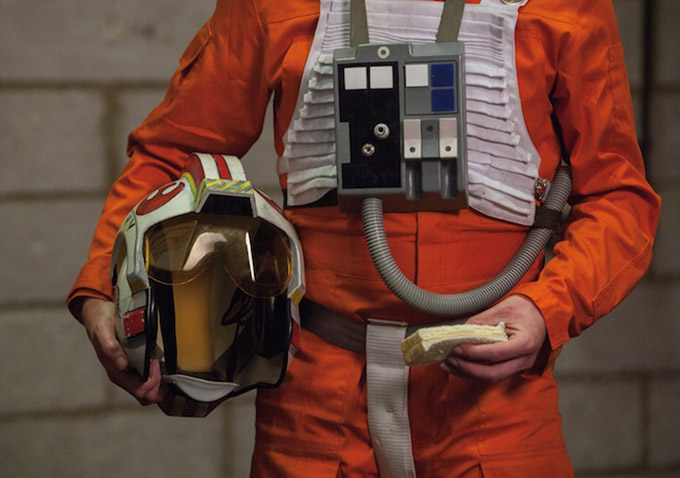 It’s not like it ever went away, but “Star Wars” mania is about to kick into a whole new gear, beginning with the release of a new trailer tonight, which will kick off a feverish two month pre-release period for the seventh official film in the franchise, followed by more sequels and spinoffs until the Earth is destroyed by a moon-sized space station.
It’s not like it ever went away, but “Star Wars” mania is about to kick into a whole new gear, beginning with the release of a new trailer tonight, which will kick off a feverish two month pre-release period for the seventh official film in the franchise, followed by more sequels and spinoffs until the Earth is destroyed by a moon-sized space station.
The film’s impact on cinema, and indeed pop culture at large, has been so enormous that it’s often easy to forget that forty years ago, “Star Wars” was an oddity, a big-budget throwback to sci-fi serials few of which, least of all those making it, would make much impact. And it’s that world that Jon Spira’s new documentary “Elstree 1976” hopes to take us, telling the story of what happened thirty-nine years ago, through the eyes of some of the smaller players.
Beginning with close-ups of the action figures that they played, however briefly (even those without lines in “Star Wars” could end up with a toy based on them), we then meet ten people who shot roles in George Lucas’ 1977 blockbuster (well, technically nine — there’s a late appearance from a tenth who had a key part in ‘The Empire Strikes Back‘). Some had roles that became icons in the universe — David Prowse, the man in Darth Vader’s suit; or Paul Blake, who played Greedo, of "shot first" fame. Others had wordless background roles, or were cut out of the film entirely.

Few seemed to make the film expecting anything more than a quick paycheck and a movie that would eventually appear on TV, but all, despite their small roles, have found the franchise playing a huge role in their lives subsequently, whether trying to run away from it, or making most of their living from convention appearances and other tie-ins. All are sweetly respectful to "Star Wars" and its fans, but it’s clear that some have healthier relationships with their fifteen out-of-focus seconds of fame than others.
For the most part, Spira (who made “Anyone Can Play Guitar,” about the Oxford music scene that spawned Radiohead and Supergrass) is focused on talking heads, but plays around with form just enough to keep things interesting. There are a few well-shot "reconstructions," with people in Stormtrooper armor hanging around on sound stages, and neatly used footage from the original film zoomed in and looping on the background appearances of our heroes.
You’ll get the occasional discussion of major actors like Harrison Ford or Alec Guinness, but for the most part, the focus is very much on the bit-players, making the film a sort of behind-the-scenes “Star Wars” version of “Rosencrantz & Guildenstern Are Dead,” a massive story told from the perspective of the little people. And though I’d perhaps argue that Spira could have narrowed down the choices here a little — there are one or two who seem interchangeable, and some who are less interesting than others — he’s mostly found an entertaining bunch to focus on.

As you might imagine, Vader gets the most screen time, and even those familiar with Prowse’s backstory — a former Mr. Universe with a thick West Country accent — will find some revelations here, particularly in his bittersweet moments near the end. Blake, an old school actor whose friendship with Anthony Daniels landed him the part of Greedo, and who has an admirably pragmatic approach to his brush with stardom, is another particularly entertaining figure, as is Canadian actor Angus MacInnes, who played an X-Wing pilot and went on to both a long acting career, and running a restaurant in Scotland for two decades.
Perhaps the film’s finest discovery might be Derek Lyons, a fresh-faced zen Buddhist and schoolteacher with his own brand of martial arts, who was a background extra in the closing scenes of “Star Wars,” but who has nevertheless struggled, by his own admission, to escape the shadow the film’s cast over his life. He’s a compelling and sympathetic tragicomic figure, one undoubtedly reminiscent of a character in “Extras,” and Spiras’ study of him is a highlight of the film.
Hardcore “Star Wars” fans looking for insight into the making of the film will find tidbits here, but the film has bigger concerns. It digs into the hierarchy of the convention circle — with Prowse lording over most, and "named parts" looking down their nose at background artists like Lyons — are fascinating. But there’s also something more profound that the film touches on: without patronizing or condescending, it’s an examination of how fame can change us and haunt us, and of the complicated relationships that survivors of something like “Star Wars” can have with it. In that, it finds a way of proving valuable not just to fans, but to Force agnostics as well. [B]
Click here for our complete coverage of the 2015 BFI London Film Festival

